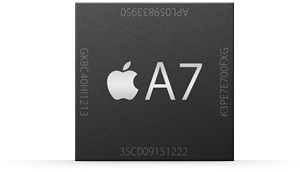
Apple launched the iPhone 5s with three key features that differentiated it from the older iPhone 5: an upgraded camera sensor, the Touch ID fingerprint sensor and an all-new A7 chip.
We’ve already told you about the upgraded camera and the Touch ID sensor, and in this post, we explain the significance of the A7 processor, and how it lays down the foundation for a 64-bit mobile computing future.
CPU: The highlight of the new A7 chip is, of course, the 64-bit “desktop-class” architecture. The A7 chip is in fact the first 64-bit smartphone system-on-chip, showing that Apple is way ahead of other smartphone manufacturers when it comes to silicon chips. Apple says, the improvements to the CPU have helped improved performance by a factor of 2.

GPU: Apart from the CPU, the A7 also has a new GPU which supports OpenGL ES 3.0, a graphical library extensively used in games and photography apps. Earlier iOS devices supported OpenGL ES 2.0, but support for 3.0 means more detailed and complex graphics, previously seen only on PCs, Macs and consoles. To demo the new GPU’s capabilities, Apple let Epic Games preview Infinity Blade 3 during the event.

ISP: Apple says the A7 chip has a new Image Signal Processor as well, though it doesn’t go into much detail apart from saying this:
The Camera app takes advantage of a new image signal processor built into A7 to give you up to 2x faster autofocus, faster photo capture, and higher video frame rates.
It’s likely that the image stabilisation is also powered by the new ISP.
M7 coprocessor: While the iPhone has had an accelerometer, compass and gyroscope since quite some time, all these sensors are packed into the M7 motion coprocessor in the iPhone 5s, which is a module independent of the CPU. This means that fitness apps can keep requesting motion related data without draining the battery or burdening the CPU. From Apple’s iPhone 5s page:
M7 knows when you’re walking, running, or even driving. For example, Maps switches from driving to walking turn-by-turn navigation if, say, you park and continue on foot. Since M7 can tell when you’re in a moving vehicle, iPhone 5s won’t ask you to join Wi-Fi networks you pass by. And if your phone hasn’t moved for a while, like when you’re asleep, M7 reduces network pinging to spare your battery.
The M7’s focus on fitness and health related apps makes it fit not just for a phone, but even for a wearable, always-tracking, fitness-focused device.

These are the main parts of the new A7 chip, but the 64-bit architecture is actually a really key feature, especially when it comes to the larger picture of the mobile computing landscape, so we’ll talk more about it below.
64-bit
Till now mobile CPUs were all 32-bit, but the A7 chip, with its 64-bit architecture, brings a modern ARMv8 instruction set, and twice the number of general purpose and floating-point registers.

While some folks are quick to dismiss the focus on 64-bit as marketing speak, the new architecture will improve performance on the iPhone 5s, if devs choose to do a little work from their end. From Apple’s 64-bit programming guide:
Starting with iOS 7, you can build iOS apps that take advantage of 64-bit processors. An app that supports 64-bit processing almost always gains improved performance when compared with a 32-bit app running on the same device.
64-bit apps can work with more data at once for improved performance. Apps that extensively use 64-bit integer math or custom NEON operations see even larger performance gains.
Apple does note that since most common data types on a 64 bit architecture will be double the size, an app’s memory consumption can increase, which makes it even more surprising that Apple doesn’t seem to have increased the RAM on the iPhone 5s.
Apple developed iOS 7 keeping the upcoming 64-bit architecture in mind, with most apps and system libraries now taking advantage of the new CPU. While existing apps will run fine on the iPhone 5s in the 32-bit mode, developers can choose to build their binaries for 64-bit architectures as well to take advantage of the new hardware. This could potentially inflate the size of apps even for older devices, as it happened when developers added Retina assets to their apps.
Now that we’ve discussed the short-term implications of the 64-bit processor, let’s discuss what Apple can be told of Apple’s future product lineup from the A7 chip.
- The most obvious prediction is that Apple’s future proofing the iOS device lineup with a 64-bit CPU, since 32-bit CPUs can address, and thus support, only up to 4GB of RAM.
- It goes without saying, that a few years down the line, Apple’s entire iOS device lineup would be 64-bit. Just like how almost all iOS devices on sale have Retina displays, and how very soon all iPhones will have 4″ screens. (Which can become bigger but not smaller.)
- Taking an even more long term view, it’s possible that Apple chooses to swap the Intel chipsets in MacBooks with a 64-bit ARM CPU, which could enable an even longer battery life. (The current MacBook Air already has a whooping 15 hour battery life)
Over the course of the past few years, Apple’s amassed a lot of talented people in the CPU design and semconductor space through hiring and acquisitions. Using this talent the company designed its own ARM CPU core called Swift, and it is now taking full advantage of this vertical integration by pushing mobile computing forward.
[Image via CNET]